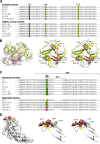Two remarkable serine/leucine polymorphisms in Helicobacter pylori: functional importance for serine protease HtrA and adhesin BabA
- PMID: 38698410
- PMCID: PMC11064359
- DOI: 10.1186/s12964-024-01635-5
Two remarkable serine/leucine polymorphisms in Helicobacter pylori: functional importance for serine protease HtrA and adhesin BabA
Abstract
Single nucleotide polymorphisms (SNPs) account for significant genomic variability in microbes, including the highly diverse gastric pathogen Helicobacter pylori. However, data on the effects of specific SNPs in pathogen-host interactions are scarce. Recent functional studies unravelled how a serine/leucine polymorphism in serine protease HtrA affects the formation of proteolytically active trimers and modulates cleavage of host cell-to-cell junction proteins during infection. A similar serine/leucine mutation in the carbohydrate binding domain of the adhesin BabA controls binding of ABO blood group antigens, enabling binding of either only the short Lewis b/H antigens of blood group O or also the larger antigens of blood groups A and B. Here we summarize the functional importance of these two remarkable bacterial SNPs and their effect on the outcome of pathogen-host interactions.
Keywords: Adaptation; BabA; Evolution; HtrA; SNP.
© 2024. The Author(s).
Conflict of interest statement
The authors declare no competing interests.
Figures

References
Publication types
MeSH terms
Substances
Grants and funding
LinkOut - more resources
Full Text Sources

